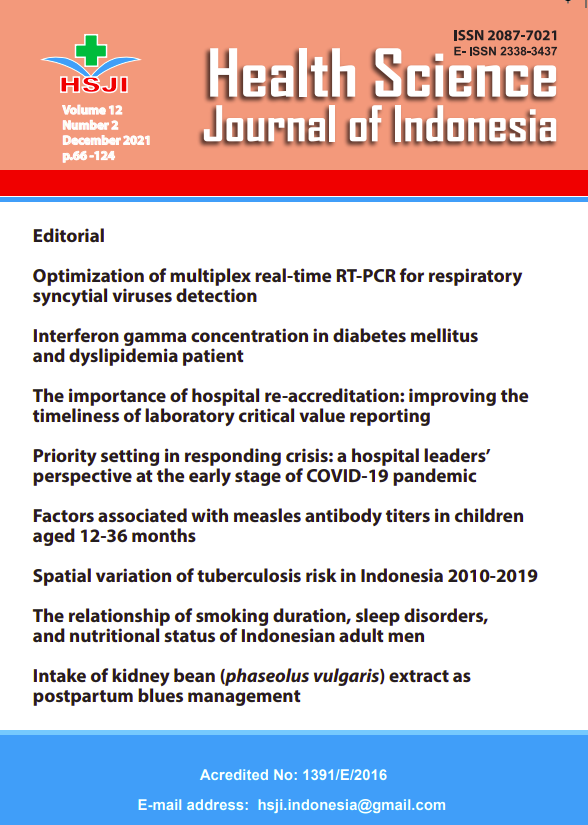Spatial variation of tuberculosis risk in Indonesia 2010-2019
Abstract
Background: As the second-highest country in tuberculosis (TB) cases globally, Indonesia has experienced an increasing trend of notification rate in the last ten years; however, the 34 provinces may have different risks. This study aims to examine TB risk variation across Indonesia in 2010-2019.
Methods: A descriptive analysis was conducted on TB routine data of 2010-2019 from the Ministry of Health. Cases included all types of TB patients. Total cases, incidence rate (IR), and standardized morbidity ratio (SMR) were calculated for each province and national level during the period. Distributions of IRs and SMRs were displayed on maps.
Results: During 2010-2019, 3,866,447 TB cases occurred in Indonesia, and the national IR was 1,523 per 100,000 populations. The highest proportion of cases and IR were in West Java (20.6%, 314 per 100,000); while the lowest was in North Kalimantan (0.2%, 3 per 100,000). Higher risks of TB occurred in DKI Jakarta (SMR 1.9), Papua (1.7), North Sulawesi (1.7), Maluku (1.5) and West Papua (1.5) among others. The smallest SMRs were found in Bali and Yogyakarta (0.5).
Conclusion: TB risk varied across Indonesia in 2010-2019, with a higher risk in DKI Jakarta and several provinces in eastern Indonesia. Given the underreporting nature of routine data, validation is required when using the finding of this study in the local-level intervention.
Keywords: tuberculosis, TB, standardized morbidity ratio, spatial variation, risk
Abstrak
Latar belakang: Sebagai negara dengan jumlah kasus tuberkulosis (TB) terbesar kedua di dunia, Indonesia menunjukkan tren peningkatan notification rate di sepuluh tahun terakhir. Akan tetapi, risiko TB di 34 provinsi bisa saja berbeda-beda. Artikel ini bertujuan mengkaji variasi risiko TB di Indonesia pada tahun 2010-2019.
Metode: Data rutin TB tahun 2010-2019 dari Kementerian Kesehatan dianalisis secara deskriptif. Kasus TB didefinisikan sebagai semua tipe pasien TB. Total jumlah kasus, incidence rate (IR), dan standardized morbidity ratio (SMR) dihitung untuk tiap provinsi dan tingkat nasional selama periode tersebut. Sebaran IR dan SMR diplot di atas peta.
Hasil: Selama 2010-2019, terdapat 3.866.447 kasus TB dan IR nasional 1.523 per 100.000 populasi. Proporsi kasus dan IR terbesar ada di Jawa Barat (20,6%, 314 per 100.000) dan terkecil di Kalimantan Utara (0,2%, 3 per 100.000). Risiko TB lebih tinggi di antaranya terjadi di DKI Jakarta (SMR 1,9), Papua (1,7), Sulawesi Utara (1,7), Maluku (1,5) dan Papua Barat (1,5). Standardized Morbidity Ratio terendah ditemukan di Bali dan Yogyakarta (0,5).
Kesimpulan: Dapat disimpulkan bahwa risiko TB beragam di seluruh Indonesia selama 2010-2019, di mana DKI Jakarta dan beberapa provinsi di timur Indonesia memiliki risiko lebih tinggi. Mengingat adanya kurang lapor dalam data rutin, validasi diperlukan jika menggunakan temuan studi ini dalam intervensi di tingkat lokal.
Kata kunci: tuberkulosis, TB, standardized morbidity ratio, variasi spasial, risiko

